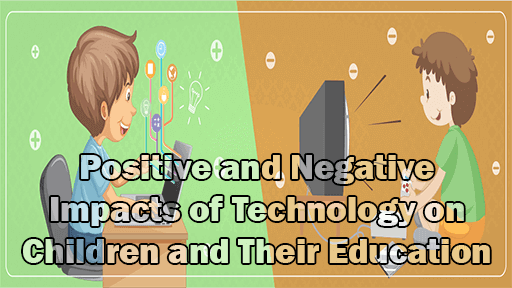Positive and Negative Impacts of Technology on Children and Their Education:
Technology has become an integral part of our daily lives, significantly influencing various aspects, including education. In recent years, children have become increasingly exposed to various technological devices and platforms that impact their learning experiences. This article explores both the positive and negative impacts of technology on children and their education.
Positive Impacts of Technology on Children and Their Education:
1. Access to Information: Technology has democratized access to information, allowing children to explore a wealth of knowledge beyond the confines of traditional classrooms. Educational websites, online databases, and digital libraries provide a vast array of resources, enabling students to engage with diverse subjects and perspectives.
2. Interactive Learning Tools: Educational apps, software, and interactive platforms engage children in immersive learning experiences. These tools use multimedia elements, simulations, and gamification to make the educational process more enjoyable and effective. The interactive nature fosters a deeper understanding of complex concepts.
3. Global Collaboration: Virtual communication tools enable children to collaborate with peers globally. Online platforms and video conferencing break down geographical barriers, fostering international collaboration. This exposure to different cultures not only broadens their worldview but also promotes skills such as teamwork, communication, and cultural sensitivity.
4. Personalized Learning: Adaptive learning technologies analyze individual student performance and tailor educational content to meet their specific needs. This personalization ensures that each child progresses at their own pace, reinforcing understanding and addressing individual learning styles. This approach accommodates diverse learning needs within a single classroom.
5. Skill Development: Educational technology plays a crucial role in developing 21st-century skills. Children gain proficiency in critical thinking, problem-solving, and digital literacy through exposure to various digital tools. These skills are essential for their future success in a technologically advanced and dynamic society.
6. Preparation for the Future: Integrating technology into education prepares children for the demands of the future workforce. As technology continues to evolve, familiarity with digital tools and online collaboration becomes a valuable asset. This early exposure ensures that students are well-equipped to navigate the complexities of the digital age in their future careers.
7. Efficiency and Time Management: Technology streamlines administrative tasks for educators, allowing them to allocate more time to actual teaching. Automated grading systems, digital lesson plans, and online collaboration tools contribute to increased efficiency in the teaching process. For students, access to online resources facilitates efficient learning, saving time that can be utilized for additional educational pursuits or extracurricular activities. The optimization of time management benefits both educators and students, enhancing the overall educational experience.
Negative Impacts of Technology on Children and Their Education:
1. Digital Distractions: The prevalence of digital devices poses a significant risk of distractions for children. With easy access to social media, online games, and entertainment, students may find it challenging to stay focused on educational tasks. This distraction can negatively impact their academic performance and hinder the learning process.
2. Socioeconomic Disparities: The integration of technology in education can widen existing socioeconomic disparities. Schools with greater financial resources can afford advanced technological tools, while less affluent institutions may struggle to provide the same level of access. This creates a digital divide, where some students have more opportunities for tech-enhanced learning than others.
3. Loss of Interpersonal Skills: Excessive screen time and reliance on digital communication may contribute to a decline in face-to-face interpersonal skills. Children who spend significant time interacting online may face challenges in developing effective communication, empathy, and social cues, impacting their ability to navigate real-world interactions.
4. Cybersecurity Risks: Increased exposure to digital platforms exposes children to cybersecurity risks. Issues such as online bullying, identity theft, and exposure to inappropriate content pose threats to their safety and well-being. Ensuring a secure online environment becomes crucial to protect children from potential harm.
5. Overemphasis on Testing: Technology can contribute to an overemphasis on standardized testing. The pressure to perform well on digital assessments may lead to a narrowing of the curriculum, with teaching strategies focused primarily on test preparation. This approach neglects the development of critical thinking, creativity, and a holistic understanding of subjects.
6. Health Concerns: Prolonged use of digital devices can lead to various health concerns for children. Issues such as eye strain, sleep disturbances, and poor posture are associated with excessive screen time. Managing screen exposure and promoting healthy technology habits are essential to address these concerns and ensure the overall well-being of students.
7. Dependence on Technology: Overreliance on technology may result in a dependence that hampers children’s resilience and adaptability. If students become accustomed to relying solely on digital tools, they may struggle to navigate traditional learning methods. This dependence can impede problem-solving skills and hinder their ability to adapt to situations where technological aids are unavailable. Balancing technology use with other forms of learning is crucial to foster a well-rounded educational experience.
In conclusion, the impact of technology on children’s education is a nuanced interplay of positive advancements and potential drawbacks. The positive aspects, such as improved access to information, personalized learning experiences, and global collaboration, showcase technology’s transformative potential in shaping a more inclusive and dynamic educational landscape. However, the negative impacts, including digital distractions, socioeconomic disparities, and potential health concerns, underscore the importance of mindful and responsible integration. Striking a balance between harnessing the benefits of technology and mitigating its risks is crucial. As we navigate the digital era, it is imperative for educators, parents, and policymakers to collaborate in fostering a technologically enriched learning environment that prioritizes both academic excellence and the holistic well-being of our children.

Library Lecturer at Nurul Amin Degree College










